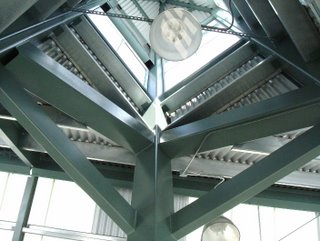
Photo looking up into Bellingham Farmer's Market clock tower. Light fixtures.
There is a lot of talk about Inclusive zoning these days. Allowing a mixture of housing types and price ranges with-in a neighborhood.
That, instead of places where only (expensive) single family homes are allowed while, across town, a ghetto of apartments is kept in one area. Like, "keep those apartments from escaping."
Inclusive zoning means a mix of housing types and income levels. Also a mix of land uses in one neighborhood. That means one can take a stroll, near one's home, and pass houses, a park, a church and an ice cream parlor.
That's more inviting than some boring "subdivision mile" with nothing but garage doors visible.
It brings diverse income groups together. More trust and understanding between social classes.
Also allows people to live closer to services and activities. Cuts car dependency.
I recently saw a good article about this concept in the July 26 06 Cascade Weekly. Written by one of our city council members, Joan Beardsley. She talked quite a bit about the good effects that "inclusive neighborhoods" have on schools.
In the past, people have spent much effort bussing kids across town to bring various elements of our society together. Well, another way to bring us together can be in how we plan our neighborhoods.
Bring various income classes together, for instance.
After pondering those encouraging words, I had a conversation with a friend in Ecuador, South America.
A conversation via Skype Internet phone.
My friend, in Ecuador, spoke of a negative consequence when the gap between wealthy and poor gets too wide. Latin American nations are noted for wide gaps between income classes.
Something that could be in USA's future, if we don't watch out. The income gap keeps getting wider.
He said single family homes are loosing popularity for the middle class in Ecuador.
Loosing popularity because the crime rate is so high that detached homes are vulnerable to break ins, robberies, even armed robberies.
It's like class warfare.
So the middle class is turning to high rises.
Condominium projects, rather than detached homes.
A condominium complex can provide centralized entrances for security and things like "windows high off the ground," away from the break-in zone.
Interesting observation.
It seems like bringing American income classes together, to lower the crime rate, might help us save the single family home.
Ironically, we may need to be less exclusive about our single family neighborhoods to save them.
Save them from the ravages of societal breakdown.

1 comment:
Great Blog, Robert.
Reading this post made me think of the American comedian, Steve Wright. He said; 'I installed a skylight in my ceiling. I think it's great, but the neighbours in the bedroom above me , are really annoyed!' ha.
You must have a great job?
Bob (aka Roberto)
http://rjs1951.googlepages.com/
Post a Comment